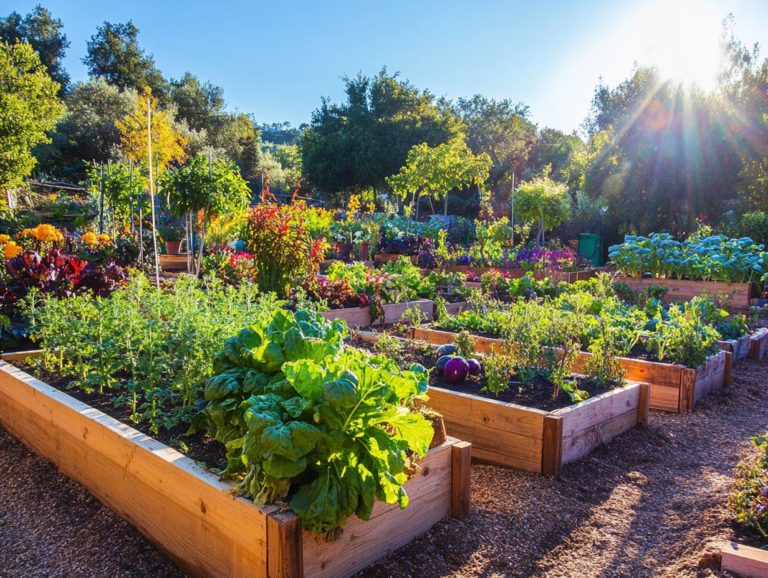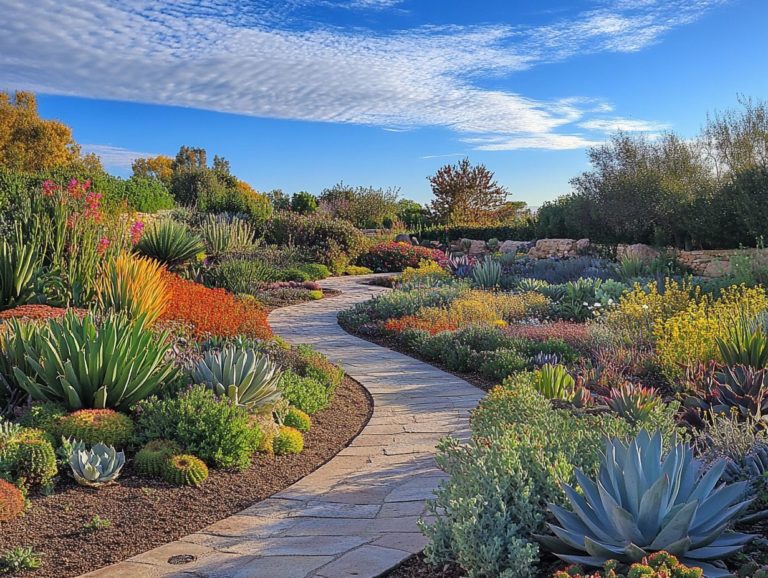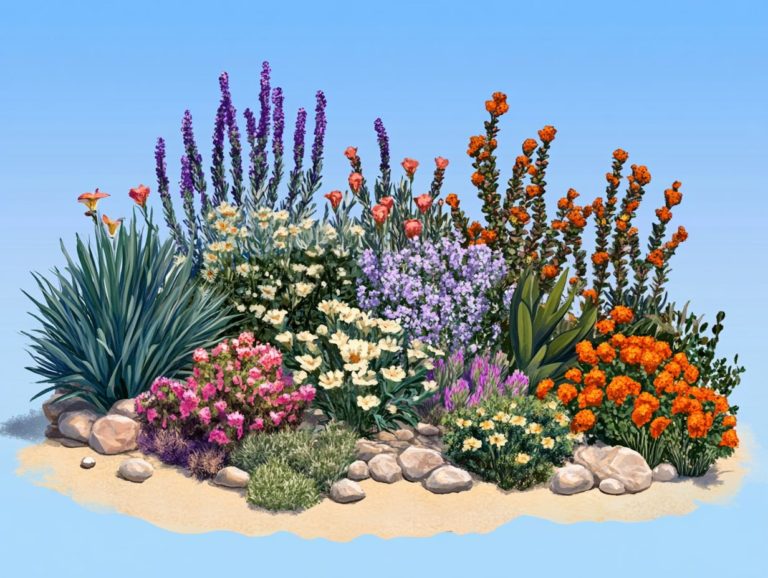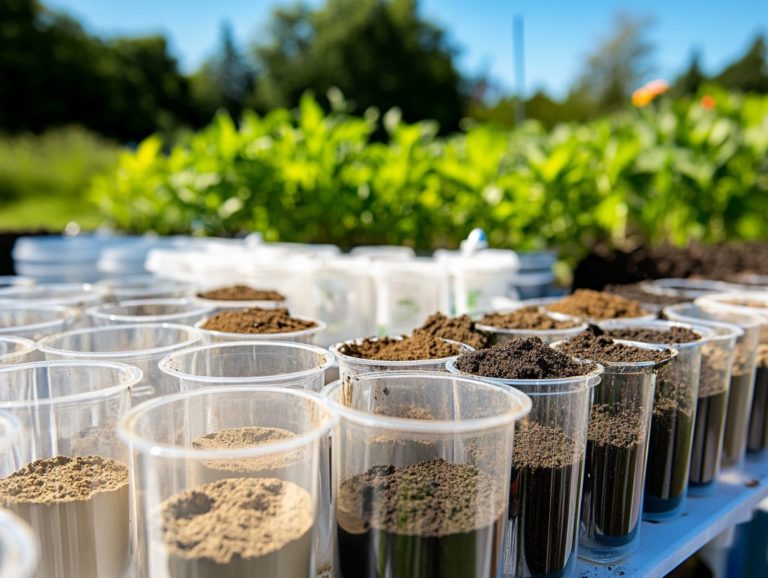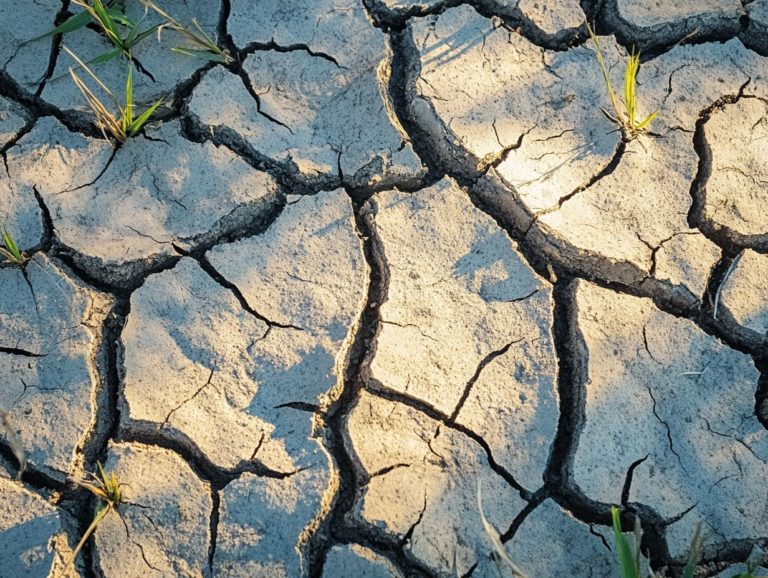Landscape Maintenance Tips for Drought Areas
Drought presents a formidable challenge to landscapes, impacting everything from plant health to soil quality.
Take a moment to explore how drought affects your environment and discover effective strategies to combat it. You’ll find insightful landscaping tips and techniques for maintaining a drought lawn.
- Drought-tolerant plants that can flourish even under harsh conditions.
- Efficient watering techniques designed to maximize water conservation.
- The numerous benefits of proper mulching.
Engage in a discussion about sustainable landscaping practices while picking up additional tips for maintaining vibrant and resilient gardens and lawns despite water scarcity.
Jump in now to turn your landscape into a stunning drought-resistant oasis with smart irrigation practices!
Contents
- Key Takeaways:
- The Impact of Drought on Landscapes
- Choosing Drought-Resistant Plants
- Efficient Irrigation Techniques
- Proper Mulching for Drought Areas
- Implementing Sustainable Landscaping Practices
- Additional Tips for Maintaining Drought-Resistant Landscapes
- Frequently Asked Questions
- 1. How can I maintain my landscape during a drought?
- 2. What plants can survive in my dry garden?
- 3. How often should I water my landscape during a drought?
- 4. Is it important to mulch during a drought?
- 5. What are some ways to conserve water in my landscape during a drought?
- 6. Are there special considerations for maintaining a lawn during a drought?
Key Takeaways:

- Select drought-resistant plants that thrive in dry conditions. This will reduce water usage and maintenance.
- Use efficient watering methods like drip irrigation and smart controllers to conserve resources.
- Practice proper mulching and reduce water use to promote a sustainable landscape.
The Impact of Drought on Landscapes
Drought profoundly influences landscapes, especially in states like Texas, California, and Florida, where maintaining a lush lawn poses a true challenge for both homeowners and landscaping professionals.
To navigate these trials effectively, it s crucial for you to grasp how drought conditions impact mature lawns and their surrounding ecosystems. This understanding will empower you to implement effective watering plans that help keep your lawn healthy and adopt sustainable landscaping practices.
By leveraging insights from turfgrass experts such as Mike Goatley and Dan Sandor of Virginia Tech, you can gain invaluable guidance on sustaining a healthy lawn during periods of drought stress while minimizing your environmental footprint and managing traffic damage.
Understanding Drought and its Effects
Understanding drought means grasping its impact on soil moisture levels, water retention capabilities, and the survival of various grass species elements that are essential for maintaining vibrant lawns and landscapes, especially in light of local weather data.
Drought transforms the delicate balance of soil types, leading to reduced water retention in sandy soils. Meanwhile, clay soils often face increased compaction that disrupts drainage. This imbalance can escalate evaporation rates as moisture dwindles, ultimately stressing grass species that aren t built to withstand dry conditions.
For instance, while Kentucky bluegrass, with its lush allure, often falters during extended dry spells, drought-resistant varieties like fescue and warm-season lawns such as Bermudagrass flourish in such circumstances.
Research indicates that lawns featuring native grasses can require 30-50% less water, underscoring the importance of choosing the right species for effective drought management. Incorporating water conservation techniques in landscaping such as effective mulching can greatly enhance soil moisture retention, fostering a resilient landscape even in the face of arid weather conditions.
Choosing Drought-Resistant Plants
Selecting the right drought-resistant plants is essential for sustainable landscaping, particularly in regions often impacted by drought. Understanding the impact of drought on landscaping choices not only conserves water but also elevates the beauty of your garden and lawn.
Consider choices like perennial ryegrass, Bermudagrass, and succulents, which thrive even under water-restricted conditions. These plants are perfect for both homeowners and landscape designers aiming for a balance of resilience and aesthetics.
By incorporating drought-tolerant plants into your landscape design, you can cultivate an environment that is not only visually appealing but also remarkably sustainable through effective soil management.
Types of Plants that Thrive in Drought Conditions
You ll find a variety of plants that thrive in drought conditions, including both cool-season grasses like fine fescue and warm-season grasses that can manage with minimal water input!
Among the cool-season options, fine fescue is particularly noteworthy for its delicate texture and resilience against heat. It also requires little irrigation.
Warm-season grasses, like Bermuda grass, not only exhibit remarkable toughness but also boast deep root systems that efficiently tap into soil moisture.
Imagine adding stunning succulents like agave and sedum to your garden! These plants bring vibrant colors and intriguing shapes. Lavender, with its stunning blooms and delightful fragrance, adds an extra layer of charm. By choosing these drought-resistant varieties, you can cultivate beautiful landscapes that contribute to water conservation efforts and significantly reduce maintenance needs.
Efficient Irrigation Techniques
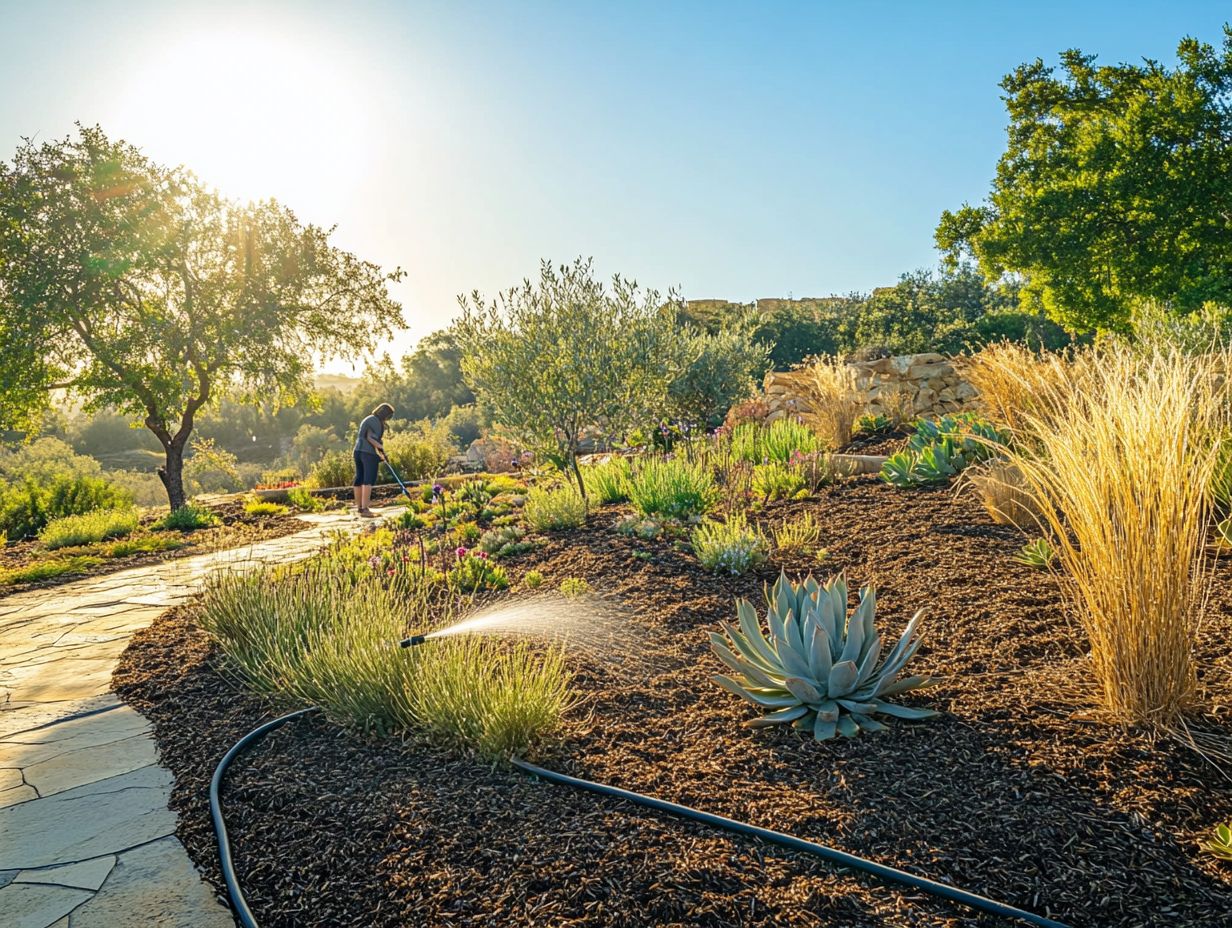
Implementing efficient irrigation techniques such as drip irrigation is essential for conserving water while ensuring your landscapes remain vibrant, especially during drought conditions. Consider exploring water management strategies for drought areas to enhance your efforts!
Design your irrigation program with modern tools. Use automatic systems and smart watering schedules. This approach allows you to deliver the precise amount of water at the optimal time. It fosters deep and infrequent watering practices, which bolster strong root systems in your plants and grasses.
Maximizing Water Usage and Conservation
Maximizing your water usage and conservation strategies begins with a solid understanding of water distribution techniques and the implementation of effective soil management practices to enhance moisture retention while considering soil types!
Start by identifying the type of soil in your lawn! Each type has its own characteristics! You ll find that sandy soils drain quickly, while clay soils do a better job of retaining moisture. To further improve your soil’s water-holding capacity, consider incorporating moisture-retaining products like hydrogels or organic mulches. These can significantly reduce your irrigation needs.
Adopting deep-and-infrequent watering techniques not only promotes deep root growth but also encourages your turf and plants to tap into moisture from lower soil layers, increasing their drought resistance. By combining these methods, you can cultivate a sustainable landscape that thrives with minimal water use!
Proper Mulching for Drought Areas
Proper mulching is crucial for anyone in drought-prone areas. It not only retains soil moisture but also suppresses weed growth and enriches the soil with organic matter, leading to healthier landscapes!
By using materials such as wood chips or straw, you can improve soil structure and enhance moisture retention. This strategy not only aids in effective weed control but also elevates the overall maintenance and aesthetic appeal of your lawn and landscaping.
Benefits and Techniques for Mulching
The benefits of mulching are substantial! You ll enjoy improved soil moisture retention, enhanced nutrient profiling through organic matter addition, and effective weed control. It’s truly an invaluable technique for achieving sustainable landscaping.
When applying mulch, selecting the right type for your landscape is essential. Options such as wood chips, straw, or grass clippings each bring their own unique advantages to the table. Aim for a depth of 2 to 4 inches to create an effective barrier, but be cautious keeping it from touching plant stems is crucial to prevent rot.
Timing also plays a significant role! Applying mulch in the spring, once the soil has warmed up, will help retain moisture during those hotter months. Conversely, a fall application can provide crucial protection for roots against frost.
By integrating mulching into your broader lawn care strategy, you promote healthier plants, reduce the frequency of watering, and cultivate a harmonious ecosystem in your garden while ensuring effective weed control!
Start transforming your garden today with these easy strategies!
Implementing Sustainable Landscaping Practices
Implementing sustainable landscaping practices is crucial for minimizing water usage and maintenance demands, especially in areas prone to frequent droughts. Exploring ways of transforming your landscape for drought not only benefits your landscape but also supports environmental stewardship.
By integrating drought-resistant plants, using efficient watering techniques like drip irrigation, and following tips for maintaining plant health in drought, you can significantly enhance the resilience of your landscape while conserving valuable resources and improving lawn maintenance.
Reducing Water Usage and Maintenance Needs

Reducing water usage and maintenance needs in your landscaping is not just about conserving resources; it’s a way to ensure that your gardens thrive and remain vibrant. For instance, maintaining a minimalist drought garden can be particularly effective during drought conditions.
Adopt smart strategies that prioritize plant selection to create a truly sustainable landscape. Choosing native and drought-tolerant species means embracing natural resilience, which translates to less water and care required over time.
Implement efficient irrigation techniques, like drip systems and soaker hoses, to cut down on waste while promoting deep root growth. Adding mulch around your plants helps retain moisture and suppress weeds, making upkeep a breeze.
By emphasizing these environmentally friendly practices in your landscaping, you enhance the beauty of your garden and contribute to a healthier ecosystem, benefiting both local wildlife and your community.
Additional Tips for Maintaining Drought-Resistant Landscapes
Maintaining drought-resistant landscapes demands a strategic approach to lawn care, ensuring your outdoor space remains resilient against drought stress and potential turf diseases. Consider incorporating small space landscaping for drought areas by using drought-tolerant plants like succulents and effectively managing foot traffic to enhance the durability of your landscape.
Implement proactive strategies to prevent traffic damage and other issues, allowing your landscape to thrive even in challenging conditions.
Strategies for Long-Term Success
Strategies for achieving long-term success in maintaining drought-resistant landscapes include comprehensive lawn care practices, effective irrigation programs, and diligent monitoring. Implementing water-saving gardening techniques for drought can prevent traffic damage while sustaining overall plant health.
These approaches not only ensure the vitality of your landscape but also enhance its resilience against environmental challenges. Thoughtful planning allows you to select the right native or drought-tolerant plants perfectly suited to your local climate and soil conditions.
Regular maintenance tasks like mulching and pruning help retain moisture and promote healthy growth. Meanwhile, adaptive management practices enable you to make necessary adjustments based on seasonal shifts and available resources.
This holistic strategy gives the power to both homeowners and landscapers to cultivate sustainable outdoor spaces that thrive, even during long, dry spells.
Frequently Asked Questions
1. How can I maintain my landscape during a drought?
Use drought-resistant plants, mulch, and water less often but deeply.
2. What plants can survive in my dry garden?
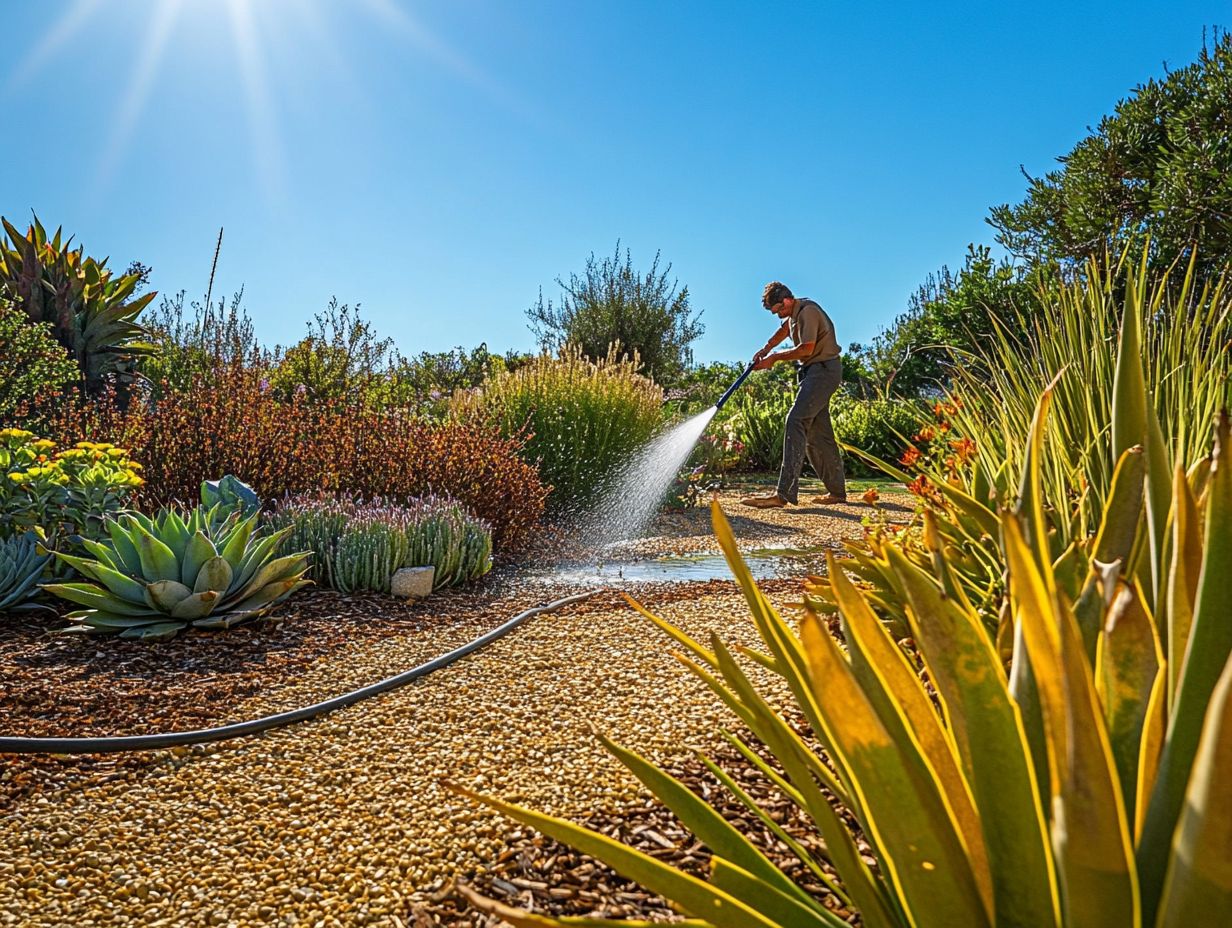
Some popular drought-resistant plants include succulents, lavender, yucca, and cacti. Research and choose plants suitable for your specific climate and location.
3. How often should I water my landscape during a drought?
Water deeply but less frequently, about 1-2 times a week, ensuring the water penetrates at least 6 inches into the ground.
Start transforming your landscape now for a greener tomorrow!
4. Is it important to mulch during a drought?
Absolutely! Mulching is crucial for keeping your landscape thriving during a drought.
It retains moisture in the soil and stops weeds from growing.
5. What are some ways to conserve water in my landscape during a drought?
You can use drought-tolerant plants and mulch to save water.
Consider installing a drip irrigation system, collecting rainwater with barrels, and checking for leaks in your irrigation system.
6. Are there special considerations for maintaining a lawn during a drought?
Lawns need a lot of water to look good, so it’s vital to manage your water use.
Raise your lawn mower blade, leave grass clippings on the lawn, and avoid watering during the hottest parts of the day to conserve water.


